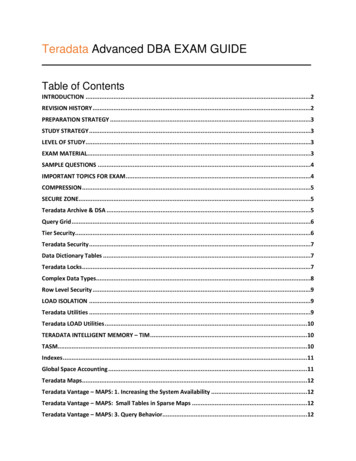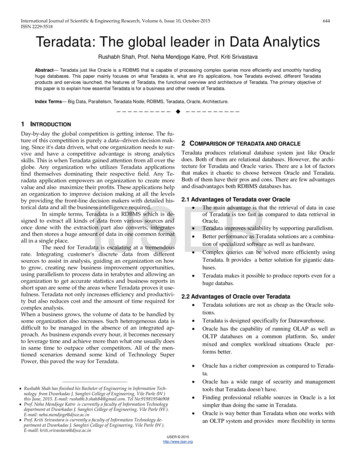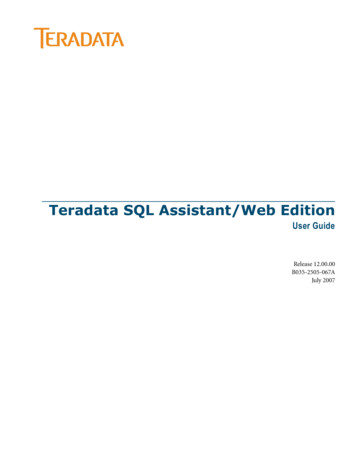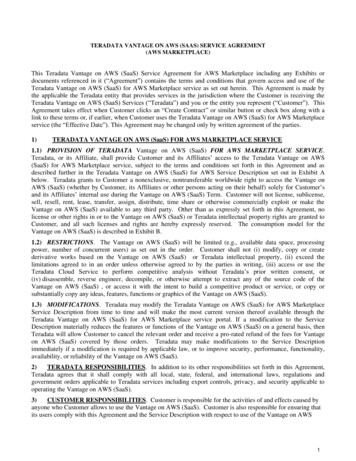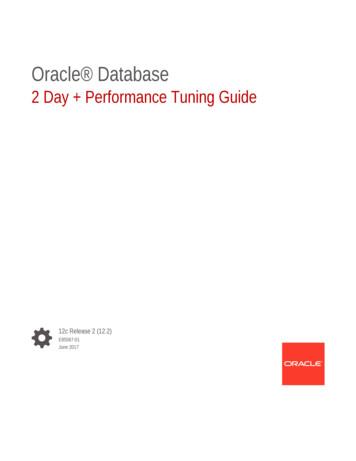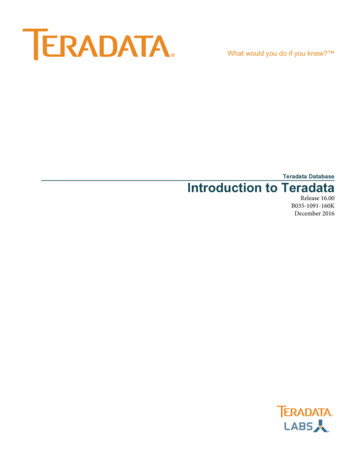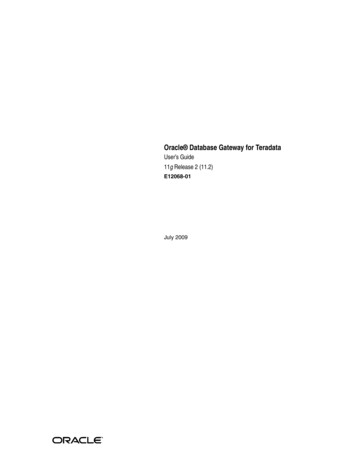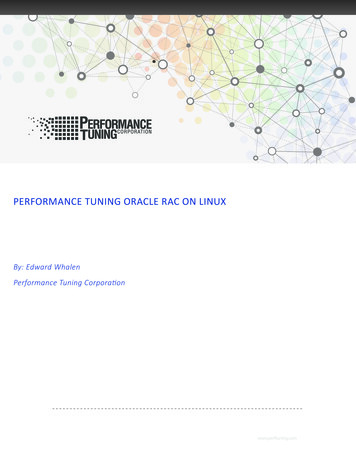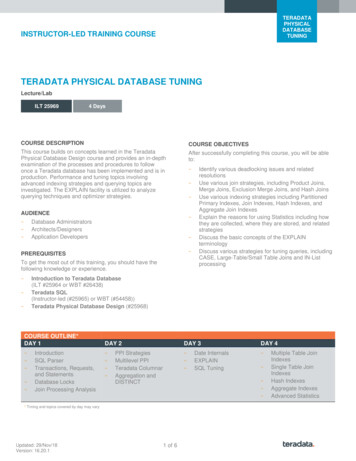
Transcription
TERADATAPHYSICALDATABASETUNINGINSTRUCTOR-LED TRAINING COURSETERADATA PHYSICAL DATABASE TUNINGLecture/LabILT 259694 DaysCOURSE DESCRIPTIONCOURSE OBJECTIVESThis course builds on concepts learned in the TeradataPhysical Database Design course and provides an in-depthexamination of the processes and procedures to followonce a Teradata database has been implemented and is inproduction. Performance and tuning topics involvingadvanced indexing strategies and querying topics areinvestigated. The EXPLAIN facility is utilized to analyzequerying techniques and optimizer strategies.After successfully completing this course, you will be ableto: AUDIENCE Database AdministratorsArchitects/DesignersApplication Developers PREREQUISITESTo get the most out of this training, you should have thefollowing knowledge or experience.Identify various deadlocking issues and relatedresolutionsUse various join strategies, including Product Joins,Merge Joins, Exclusion Merge Joins, and Hash JoinsUse various indexing strategies including PartitionedPrimary Indexes, Join Indexes, Hash Indexes, andAggregate Join IndexesExplain the reasons for using Statistics including howthey are collected, where they are stored, and relatedstrategiesDiscuss the basic concepts of the EXPLAINterminologyDiscuss various strategies for tuning queries, includingCASE, Large-Table/Small Table Joins and IN-ListprocessingIntroduction to Teradata Database(ILT #25964 or WBT #26438)Teradata SQL(Instructor-led (#25965) or WBT (#54458))Teradata Physical Database Design (#25968) COURSE OUTLINE*DAY 1 IntroductionSQL ParserTransactions, Requests,and StatementsDatabase LocksJoin Processing AnalysisDAY 2 DAY 3PPI StrategiesMultilevel PPITeradata ColumnarAggregation andDISTINCT Date InternalsEXPLAINSQL TuningDAY 4 * Timing and topics covered by day may varyUpdated: 29/Nov/18Version: 16.20.11 of 6Multiple Table JoinIndexesSingle Table JoinIndexesHash IndexesAggregate IndexesAdvanced Statistics
TERADATAPHYSICALDATABASETUNINGCOURSE CONTENTModule 0 – IntroductionRecommended Prerequisite KnowledgeCourse ObjectivesCourse ModulesData Warehouse Usage Evolution Module 1 - SQL Parser Internal, Channel, and LAN Parcels Request Parcel The Data Parcel SQL Parser Overview Software Cache Request-to-Steps Cache Request-to-Steps Cache Check Request-to-Steps Cache Logic Syntaxer Resolver Dictionary Cache Statistics Cache Security Optimizer Generator Apply and Dispatcher SQL Parser Review Summary Review Questions Module 3 - Database Locks Locks The Lock Queue Locking Modifier The NOWAIT Option ANSI Isolation Levels Isolation Levels and STARTUP Strings What Is a Deadlock? Distinct Pseudo Tables and the Global Deadlock Deadlock Handling Locking Inside Views Multi-Statement Requests Locking Inside Views with no Locking Modifier Locking Inside Views Local Deadlocks Conflicting Locks and Multi-Statement Requests Accessing Lock Contentions Deadlock Guidelines Review Questions Lab ExercisesModule 2 - Transactions, Requests, and Statements Transaction Processing Discussion Processing SQL Statement Processing Request Processing Teradata Database Mode Implicit TransactionProcessing Teradata Database Mode Explicit TransactionProcessing More on Processing Modes BTET – Implicit Transaction Processing BTET – Explicit Transaction Processing BTET – Failed Transaction Processing The Request BTET – DDL and Transaction Processing BTET Mode and Delete Table ANSI Mode Transaction Processing ANSI – DDL and Transaction Processing ANSI Mode and Delete Table Comparison of ANSI and Teradata Modes BTEQ and Request Processing Setting the Transaction Mode in BTEQ “SQL Assistant” and Request Processing Setting the Mode in “SQL Assistant” Teradata Studio and Request ProcessingUpdated: 29/Nov/18Version: 16.20.1Changing the Transaction Mode in Teradata StudioANSI Mode and “SQL Assistant”BTET Mode and “SQL Assistant”Module 2: SummaryModule 2: Review QuestionsModule 2: Lab ExercisesModule 4 - Join Processing Analysis Join Processing Product Join Product Join Explain Merge Join Merge Join with Duplication and Sorting Merge Join Strategy Merge Join with Row Redistribution Merge Join with Redistribution Explain Merge Join with Matching Primary Indexes Merge Join on Matching Primary Indexes Explain Alternative to Using OR Join Conditions Exclusion Joins Exclusion Merge Join Explain Inclusion Merge Join Explain Hash Joins Three-Table Join Explain Partial Redistribution and Partial Duplication (PRPD) PRPD Join Steps Simplified Three-Way PRPD Explanation Teradata PRPD Join Example PRPD One Relation Skewed on a Non-PI Column Nested Joins2 of 6
TERADATAPHYSICALDATABASETUNING Nested Join ExplainJoin Processing ObservationsReview Questions Module 5 - PPI Strategies Logical Example of NPPI versus PPI File System Changes General Row Layout Secondary Index Changes (for PPI) NUSIs and Partition Elimination Miscellaneous SQL – Row Identifiers Index Constraints View Utility Considerations Join Considerations with PPI NPPI to PPI Join – Sliding Window NPPI to PPI Join – Hash Ordered Spool File Join PPI to PPI Join – Rowkey-Based Join EXPLAIN Terminology 14.10 EXPLAIN Terminology & Modifiers Product Join Enhanced by DPE Row Hash Match Scan Merge Join – Enhanced byDPE Partitioning Strategies Guidelines PPI Enhancements Teradata 14.0 PPI Enhancements Summary Review Questions Lab Exercises Module 6 - Multilevel PPI Multilevel PPI Concepts Multilevel Partitioning Example Three-Level PPI Example Qualifying All Partition Columns Qualifying #L1 and #L2 Qualifying #L1 and #L3 Qualifying #L2 and #L3 Qualifying #L1 Qualifying #L2 Different PI and Partition Columns Evaluating the Partitioning Expression Evaluating a Three-Level Partition Contrasting Styles Things to Consider Module 6: Summary Module 6: Review Questions Module 6: Lab Exercises Module 8 - Aggregation and DISTINCT Aggregations ARSA Algorithm A Query and Its Data Local Aggregation Local Aggregation – Cache Overflow Redistributing the Aggregate Cache Sort Global Aggregation More on Local vs. Global AggregationModule 7 - Teradata Columnar Teradata Columnar IntroductionUpdated: 29/Nov/18Version: 16.20.1Teradata Columnar BenefitsColumnar vs. Row Format ComparisonColumnar I/O Savings IllustrationColumnar DrawbackNo Primary Index Table DDLThe No Primary Index TableColumn Partition Table DDL (with Auto-Compression)Column Partition Table DDL (without AutoCompression)Column Partition Container (NO AUTO COMPRESS)The Column Partition Table (NO AUTO COMPRESS)CP Table Query #1 (NO AUTO COMPRESS)Auto-Compression for CP TablesAuto-Compression Techniques for CP TablesUser-Defined Compression TechniquesColumn Partition Container (Automatic Compression)The Column Partition Table (with Auto-Compression)Table Query #2 (with Auto-Compression)CP Table with Row Partitioning DDLThe Column Partition Table (with Row Partitioning)CP Table with Multi-Column Container DDLThe CP Table with Multi-Column ContainerCP Table Hybrid Row & Column Store DDLThe CP Table (with Hybrid Row & Column Store)Populating a CP TableDELETE ConsiderationsUPDATE and USI/NUSI ConsiderationsCP Table RestrictionsPartitioning OptionsColumn-Partitioned Primary IndexNoPI Table OptionsTD14.10 Available SyntaxTeradata 14.10 Columnar EnhancementsTD15.10 – Columnar Table with Primary AMPTD15.10 – Columnar Table with Primary IndexSample Statistics on PPI TablesSummaryReview QuestionsLab Exercises3 of 6
TERADATAPHYSICALDATABASETUNING DISTINCT ProcessingStep 1: RedistributionStep 2: Eliminate Duplicate RowsOptimization: Aggregate Processing for DISTINCTMultiple COUNT DISTINCTAggregation and Distinct SummaryModule 8: Review Questions Module 9 - Date Internals Integer vs. Date Arithmetic Checking for Valid Dates Determining Integers for Dates Dates Prior to 1900 Determining Date vs. Integer Arithmetic Using Concatenation to Get Year and Month Automating Date Computations Using Date Functions Using FORMAT to Get Year and Month Be Careful When Doing Computations! Other FORMAT Options Review Questions Lab ExercisesModule 12 - SQL Tuning: Part 2 Outer Join Defined ON/AND (Condition on Inner Table) WHERE (Condition on Inner Table) ON/AND (Condition on Outer Table) WHERE (Condition on Outer Table) NOT IN on Nullable Columns Beginning with the IN List Changing the IN to NOT IN Applying Truth Table Logic Changing the WHERE Condition Outer Join Alternative to Nullable NOT IN Writing the Outer Join Alternative Analyzing the Outer Join Alternative Correlated Subquery for Nullable NOT IN Views with Inner Joins Views with Outer Joins Establishing Uniqueness for the Optimizer Partial GROUP BY (PGB) – “Early-Aggregation” “Early Aggregation” – Limitation Partial GROUP BY (PGB) and “Partial Sum” Review Questions Lab ExercisesModule 10 - EXPLAIN EXPLAIN Facility EXPLAIN Terminology 15.10 EXPLAIN Terminology 16.00 EXPLAIN Terminology Row and Time Estimates What is Peeking? Peeking at Parameterized Values Collected Statistics? No Collected Statistics With Collected Statistics Also with Collected Statistics Joins and Incremental Planning and Execution Incremental Planning and Execution (IPE) EXPLAINing Aggregation Parallel Steps EXPLAIN with Parallel Steps EXPLAIN of a SELECT (BMSMS) EXPLAIN of a CREATE TABLE EXPLAIN of ORed NUSI’s EXPLAINing NOT IN on NULLable Columns Single Sender Redistribution (SSR) Summary Review QuestionsModule 13 - Multiple Table Join Indexes Join Indexes What Is a Multi-Table Join Index? Compressed Join Index How Are Compressed Join Indexes Stored? An Inner Join Example EXPLAINing the Join An Outer Join Join Index – Outer Join The Same Inner Join Will the Optimizer Use the Join Index? Naming a Column The EXPLAIN A Three-Way with Outer Join The Same Inner Join A Two-Table Join Index and a Three-Table Join The Three-Way Join Avoiding RedistributionModule 11 - SQL Tuning: Part 1 Non-Correlated Subquery Processing Correlated Subquery ProcessingUpdated: 29/Nov/18Version: 16.20.1ComparisonNOT IN vs. Not EqualExamining LT/ST JoinsIn-List Processing – IntroductionIn-List ProcessingEnhanced IN-List Star Join StrategyIN-List Access PathReview Questions4 of 6
TERADATAPHYSICALDATABASETUNING Fully Covering One JoinUsing a Value-Ordered NUSIValue Ordered NUSI and a Range ConstraintThe EXPLAINValue-Ordered Primary IndexRevisiting the Range ConstraintThe New EXPLAINA Sparse Join IndexSparse Join Index StrategiesMulti-Table Join Index with Multilevel PPIMulti-Table Join Index with Multilevel PPI ExplainPreserve Join Index Column CompressionMore Information on Join IndexesReview QuestionsLab ExercisesOptional Lab Exercises Module 16 - Aggregate Indexes Aggregate Join Index Simple Aggregate Join Index Show of Aggregate Join Index Computing an Average A Simple Aggregate Join Index DELETE and the Aggregate Join Index Simple Multi-Table Aggregate Index Sparse Aggregate Index Using EXTRACT with Aggregate Index Non-Compressed Join Indexes and Aggregation NUSI Aggregation Multi-Table Compressed Join Indexes and Aggregation An Extreme Multi-Table Compressed Join Index Aggregate Join Index with PPI Notes on JOIN/HASH Indexes Review Questions Lab ExercisesModule 14 - Single Table Join Indexes A Single-Table Join Index A Single-Table Non-Compressed Join Index Another Single-Table Join Index A Single-Table Join Index Strategy The Rewrite Column Partitioned Join Index Using the Rowid for Partial Covering The Strategy The Tables Using the Rowid The Join-Back The Strategy The USI Alternative The Global Index Global Index Usage Global Usage EXPLAIN NUSI EXPLAIN Review QuestionsModule 17 - Advanced Statistics Statistics Review Optimizer’s Search for Statistics Statistics Extrapolation Dedicated Statistics Dictionary Cache Refresh or Re-Collect Statistics COLLECT STATISTICS Command (Index Format with14.0 Options) Statistics Data – What is Collected? Table Level Statistics Data Table Level Summary Statistics Collect Statistics PARTITION Option Statistic Histogram Keeps History Show Summary Statistics Values on Table SUMMARY Statistics after Three Collections Rollup Optimization ROLLUP Stats Performance Optimization Pre-Aggregate Optimization SHOW STATISTICS Options SHOW STATISTICS Sample Output SHOW STATISTICS VALUES Sample Output Transfer of Statistics HELP STATISTICS HELP CURRENT STATISTICS Privileges Statistics Collection CustomizationModule 15 - Hash Indexes What is a Hash Index? Why Would You Use a Hash Index? Comparison to Join Indexes Why the Dramatic Difference? About Compression and Structure A Hash Ordered Strategy Join-Back Strategy Join-Back EXPLAIN Reviewing the Locks Value-Ordered, Compressed, Single-Table Join Index Value Ordered NUSI Strategy Join Index StrategyUpdated: 29/Nov/18Version: 16.20.1Contrast These IndexesThe Classic Large-Table/Small-Table JoinWhat We’d Like to SeeThe EXPLAINReview Questions5 of 6
TERADATAPHYSICALDATABASETUNING Collect Statistics MAXINTERVALS OptionCollect Statistics MAXVALUELENGTH OptionUser-Specified Column Ordering and NamingSingle Table Expression StatisticsStatistics Recollection OptimizationsThreshold Functionality – Reduce UnnecessaryCollectionsSetting ThresholdsCollect Statistics SAMPLE OptionIdentifying Sampled Percentage ValuesIdentifying Unused StatisticsFinding Missing StatisticsTeradata 14.10 AutoStats FeaturesTeradata Stats Manager PortletSummaryReview QuestionsLab ExercisesUpdated: 29/Nov/18Version: 16.20.16 of 6
TERADATA PHYSICAL DATABASE TUNING Updated: 29/Nov/18 Version: 16.20.1 5 of 6 Fully Covering One Join Using a Value-Ordered NUSI Value Ordered NUSI and a Range Constraint The EXPLAIN Value-Ordered Primary Index Revisiting the Range Constraint The New EXPLAIN A Sparse Join Index Sparse Join Index Strategies Multi-Table Join Index with Multilevel PPI

